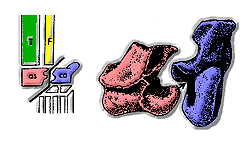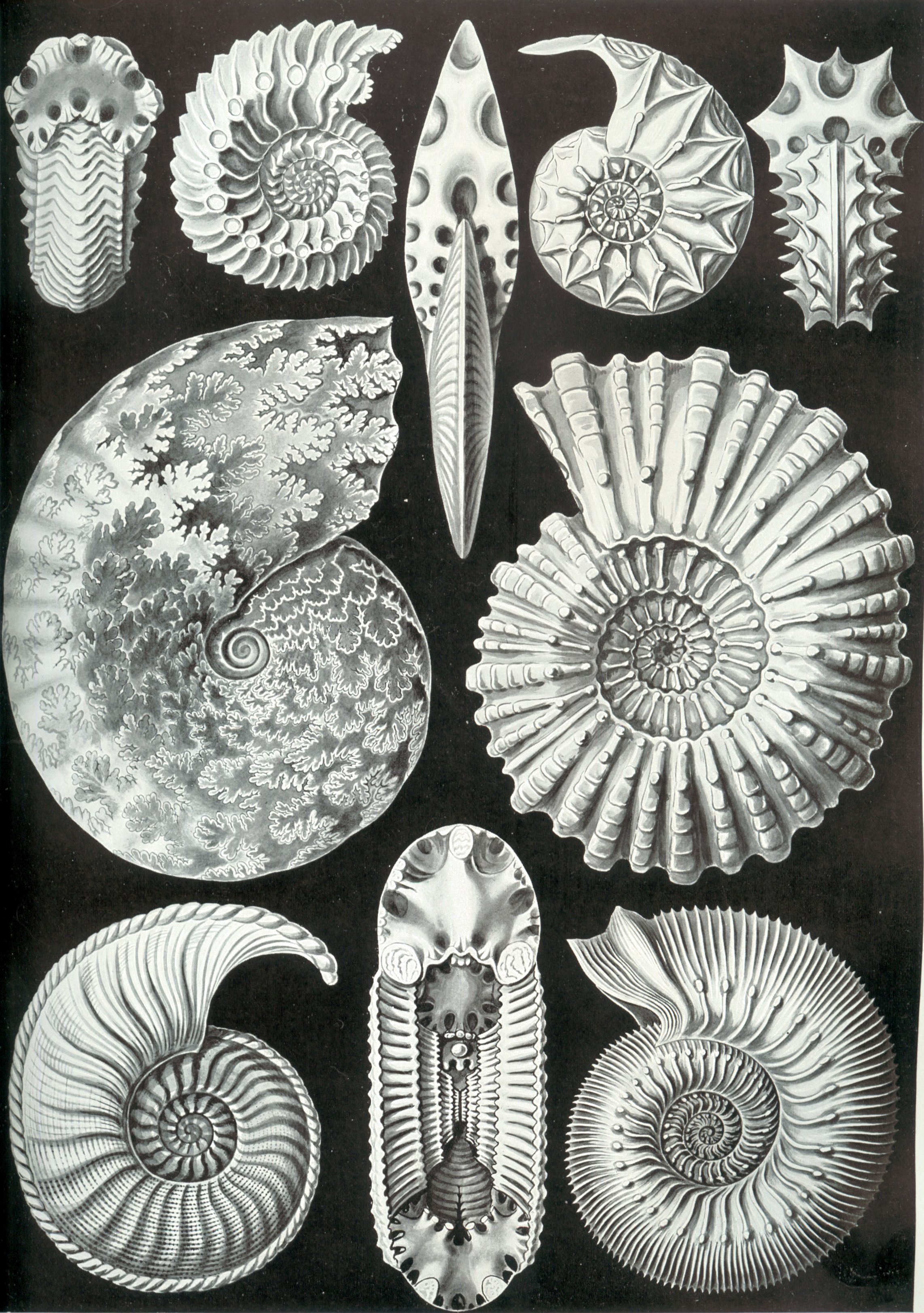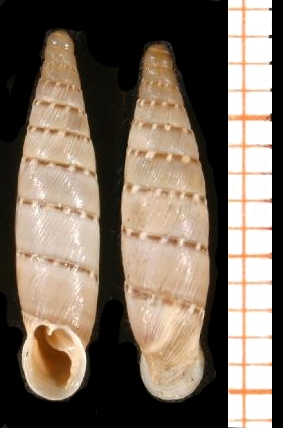anatomical suture on:
[Wikipedia]
[Google]
[Amazon]
In
 The
The
 In the type of
In the type of
 In cephalopod mollusks which have external shells (e.g. ''
In cephalopod mollusks which have external shells (e.g. ''
 Nearly all snail shells (except for the shells of
Nearly all snail shells (except for the shells of
 A trilobite's carapace consisted of calcite and
A trilobite's carapace consisted of calcite and
anatomy
Anatomy () is the branch of biology concerned with the study of the structure of organisms and their parts. Anatomy is a branch of natural science that deals with the structural organization of living things. It is an old science, having it ...
, a suture is a fairly rigid joint between two or more hard elements of an organism, with or without significant overlap of the elements.
Sutures are found in the skeletons or exoskeletons of a wide range of animals, in both invertebrate
Invertebrates are a paraphyletic group of animals that neither possess nor develop a vertebral column (commonly known as a ''backbone'' or ''spine''), derived from the notochord. This is a grouping including all animals apart from the chordate ...
s and vertebrate
Vertebrates () comprise all animal taxa within the subphylum Vertebrata () (chordates with backbones), including all mammals, birds, reptiles, amphibians, and fish. Vertebrates represent the overwhelming majority of the phylum Chordata, with c ...
s. Sutures are found in animals with hard parts from the Cambrian period to the present day. Sutures were and are formed by several different methods, and they exist between hard parts that are made from several different materials.
Vertebrate skeletons
The skeletons of vertebrate animals (fish, amphibians, reptiles, birds, and mammals) are made ofbone
A bone is a rigid organ that constitutes part of the skeleton in most vertebrate animals. Bones protect the various other organs of the body, produce red and white blood cells, store minerals, provide structure and support for the body, ...
, in which the main rigid ingredient is calcium phosphate
The term calcium phosphate refers to a family of materials and minerals containing calcium ions (Ca2+) together with inorganic phosphate anions. Some so-called calcium phosphates contain oxide and hydroxide as well. Calcium phosphates are whi ...
.
Cranial sutures
 The
The skull
The skull is a bone protective cavity for the brain. The skull is composed of four types of bone i.e., cranial bones, facial bones, ear ossicles and hyoid bone. However two parts are more prominent: the cranium and the mandible. In humans, th ...
s of most vertebrates
Vertebrates () comprise all animal taxa within the subphylum Vertebrata () (chordates with backbones), including all mammals, birds, reptiles, amphibians, and fish. Vertebrates represent the overwhelming majority of the phylum Chordata, with c ...
consist of sets of bony plates held together by cranial sutures
In anatomy, fibrous joints are joints connected by fibrous tissue, consisting mainly of collagen. These are fixed joints where bones are united by a layer of white fibrous tissue of varying thickness. In the skull the joints between the bones ar ...
. These sutures are held together mainly by Sharpey's fibers
Sharpey's fibres (bone fibres, or perforating fibres) are a matrix of connective tissue consisting of bundles of strong predominantly type I collagen fibres connecting periosteum to bone. They are part of the outer fibrous layer of periosteum, en ...
which grow from each bone into the adjoining one.
Sutures in the ankles of land vertebrates
 In the type of
In the type of crurotarsal A crurotarsal joint is one that’s situated between the bones of ''crus'', i.e. shin (tibia and fibula) and the proximal tarsal bones, i.e. astragalus and calcaneum.
The ankle joint of therian mammals (marsupials and placentals) is a crurotarsal ...
ankle which is found in crocodilia
Crocodilia (or Crocodylia, both ) is an order of mostly large, predatory, semiaquatic reptiles, known as crocodilians. They first appeared 95 million years ago in the Late Cretaceous period ( Cenomanian stage) and are the closest livi ...
ns and some other archosaurs, the astragalus
''Astragalus'' is a large genus of over 3,000 species of herbs and small shrubs, belonging to the legume family Fabaceae and the subfamily Faboideae. It is the largest genus of plants in terms of described species. The genus is native to tempe ...
is fixed to the tibia
The tibia (; ), also known as the shinbone or shankbone, is the larger, stronger, and anterior (frontal) of the two bones in the leg below the knee in vertebrates (the other being the fibula, behind and to the outside of the tibia); it connects ...
by a suture, and the joint bends around a peg on the astragalus, which fits into a socket in the calcaneum
In humans and many other primates, the calcaneus (; from the Latin ''calcaneus'' or ''calcaneum'', meaning heel) or heel bone is a bone of the tarsus of the foot which constitutes the heel. In some other animals, it is the point of the hock.
...
.
Invertebrate exoskeletons
In molluscs
The shells of most molluscs are made of calcium carbonate (the main constituent oflimestone
Limestone ( calcium carbonate ) is a type of carbonate sedimentary rock which is the main source of the material lime. It is composed mostly of the minerals calcite and aragonite, which are different crystal forms of . Limestone forms whe ...
and chalk
Chalk is a soft, white, porous, sedimentary carbonate rock. It is a form of limestone composed of the mineral calcite and originally formed deep under the sea by the compression of microscopic plankton that had settled to the sea floor. Ch ...
), and of conchiolin
Conchiolins (sometimes referred to as conchins) are complex proteins which are secreted by a mollusc's outer epithelium (the mantle).
These proteins are part of a matrix of organic macromolecules, mainly proteins and polysaccharides, that ass ...
, a protein. For more information, see Mollusc shell
The mollusc (or molluskOften spelled mollusk shell in the USA; the spelling "mollusc" are preferred by ) shell is typically a calcareous exoskeleton which encloses, supports and protects the soft parts of an animal in the phylum Mollusca, wh ...
.
Sutures in the shells of cephalopods
 In cephalopod mollusks which have external shells (e.g. ''
In cephalopod mollusks which have external shells (e.g. ''Nautilus
The nautilus (, ) is a pelagic marine mollusc of the cephalopod family Nautilidae. The nautilus is the sole extant family of the superfamily Nautilaceae and of its smaller but near equal suborder, Nautilina.
It comprises six living species in ...
'', ammonites
Ammonoids are a group of extinct marine mollusc animals in the subclass Ammonoidea of the class Cephalopoda. These molluscs, commonly referred to as ammonites, are more closely related to living coleoids (i.e., octopuses, squid and cuttl ...
), the shell is divided into compartments by septa
The Southeastern Pennsylvania Transportation Authority (SEPTA) is a regional public transportation authority that operates bus, rapid transit, commuter rail, light rail, and electric trolleybus services for nearly 4 million people in five c ...
(partitions).
The septa are joined to the external shell by sutures formed by repeated invagination (they interlock like pieces of a jigsaw puzzle
A jigsaw puzzle is a tiling puzzle that requires the assembly of often irregularly shaped interlocking and mosaiced pieces, each of which typically has a portion of a picture. When assembled, the puzzle pieces produce a complete picture.
In t ...
). The sutures are visible from the outside and often form complex and elaborate patterns.
The suture in the shells of gastropods
 Nearly all snail shells (except for the shells of
Nearly all snail shells (except for the shells of limpets
Limpets are a group of aquatic snails that exhibit a conical shell shape (patelliform) and a strong, muscular foot. Limpets are members of the class Gastropoda, but are polyphyletic, meaning the various groups called "limpets" descended indep ...
, abalone, sea hares, etc.) can be visualized as a tube of increasing diameter, closed at the small end, and spirally wrapped around a central axis. For more information, see Gastropod shell
The gastropod shell is part of the body of a gastropod or snail, a kind of mollusc. The shell is an exoskeleton, which protects from predators, mechanical damage, and dehydration, but also serves for muscle attachment and calcium storage. Some ...
.
Each complete rotation of this spirally-arranged tube is called a whorl. The whorls of a snail shell usually overlap one another, forming a spire
A spire is a tall, slender, pointed structure on top of a roof of a building or tower, especially at the summit of church steeples. A spire may have a square, circular, or polygonal plan, with a roughly conical or pyramidal shape. Spires a ...
. Where the whorls overlap, there is usually a clear (if narrow) indentation. This indentation forms a visible line, which is continuous and reaches from the apex
The apex is the highest point of something. The word may also refer to:
Arts and media Fictional entities
* Apex (comics), a teenaged super villainess in the Marvel Universe
* Ape-X, a super-intelligent ape in the Squadron Supreme universe
*Apex, ...
of the shell to the aperture
In optics, an aperture is a hole or an opening through which light travels. More specifically, the aperture and focal length of an optical system determine the cone angle of a bundle of rays that come to a focus in the image plane.
An ...
; this line is the suture.
Details of the suture are often useful in discriminating one species from another, for example, sometimes the suture is channeled.
The suture also provides a sort of geographic marker from which one can refer to the positioning of patterning or sculpture
Sculpture is the branch of the visual arts that operates in three dimensions. Sculpture is the three-dimensional art work which is physically presented in the dimensions of height, width and depth. It is one of the plastic arts. Durable ...
, where that is relevant: for example some species have a darker or lighter subsutural band on the shell.
When an angulation of the whorls occurs, the space between it and the suture above it (i.e. the abaxial edge of the sutural ramp) constitutes the area known as the "shoulder" of the shell. The shoulder angle may be simple or keeled, and may sometimes have nodes or spines
In arthropods
Sutures in the carapaces of trilobites
calcium phosphate
The term calcium phosphate refers to a family of materials and minerals containing calcium ions (Ca2+) together with inorganic phosphate anions. Some so-called calcium phosphates contain oxide and hydroxide as well. Calcium phosphates are whi ...
deposited on a lattice (framework) of chitin (a polysaccharide).
The trilobite body is divided into three major sections: a cephalon (head section) with eyes, mouthparts and sensory organs such as antennae; a thorax of multiple segments which are similar to each other; and a pygidium, or tail section.
In many species the cephalon had sutures running from back to front round the outside edges of the eyes. These sutures divided the cephalon into 3 pieces.
The sutures in trilobites' cephalons were unusual because it seems their main function was to create ''weaknesses'' which made it easy for this part of the carapace ("armor") to split when the animal needed to molt
In biology, moulting (British English), or molting (American English), also known as sloughing, shedding, or in many invertebrates, ecdysis, is the manner in which an animal routinely casts off a part of its body (often, but not always, an outer ...
.
References
{{Authority control Skeletal system Animal anatomy Mollusc anatomy